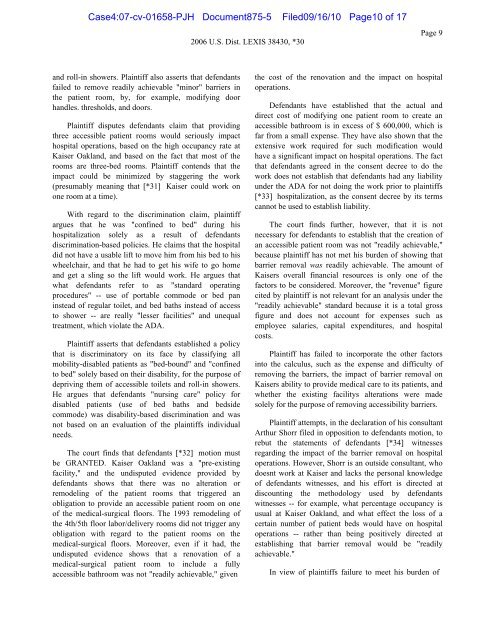exhibit 2 - SAP Lawsuit Portal
exhibit 2 - SAP Lawsuit Portal
exhibit 2 - SAP Lawsuit Portal
You also want an ePaper? Increase the reach of your titles
YUMPU automatically turns print PDFs into web optimized ePapers that Google loves.
Case4:07-cv-01658-PJH Document875-5 Filed09/16/10 Page10 of 17<br />
and roll-in showers. Plaintiff also asserts that defendants<br />
failed to remove readily achievable "minor" barriers in<br />
the patient room, by, for example, modifying door<br />
handles. thresholds, and doors.<br />
Plaintiff disputes defendants claim that providing<br />
three accessible patient rooms would seriously impact<br />
hospital operations, based on the high occupancy rate at<br />
Kaiser Oakland, and based on the fact that most of the<br />
rooms are three-bed rooms. Plaintiff contends that the<br />
impact could be minimized by staggering the work<br />
(presumably meaning that [*31] Kaiser could work on<br />
one room at a time).<br />
With regard to the discrimination claim, plaintiff<br />
argues that he was "confined to bed" during his<br />
hospitalization solely as a result of defendants<br />
discrimination-based policies. He claims that the hospital<br />
did not have a usable lift to move him from his bed to his<br />
wheelchair, and that he had to get his wife to go home<br />
and get a sling so the lift would work. He argues that<br />
what defendants refer to as "standard operating<br />
procedures" -- use of portable commode or bed pan<br />
instead of regular toilet, and bed baths instead of access<br />
to shower -- are really "lesser facilities" and unequal<br />
treatment, which violate the ADA.<br />
Plaintiff asserts that defendants established a policy<br />
that is discriminatory on its face by classifying all<br />
mobility-disabled patients as "bed-bound" and "confined<br />
to bed" solely based on their disability, for the purpose of<br />
depriving them of accessible toilets and roll-in showers.<br />
He argues that defendants "nursing care" policy for<br />
disabled patients (use of bed baths and bedside<br />
commode) was disability-based discrimination and was<br />
not based on an evaluation of the plaintiffs individual<br />
needs.<br />
The court finds that defendants [*32] motion must<br />
be GRANTED. Kaiser Oakland was a "pre-existing<br />
facility," and the undisputed evidence provided by<br />
defendants shows that there was no alteration or<br />
remodeling of the patient rooms that triggered an<br />
obligation to provide an accessible patient room on one<br />
of the medical-surgical floors. The 1993 remodeling of<br />
the 4th/5th floor labor/delivery rooms did not trigger any<br />
obligation with regard to the patient rooms on the<br />
medical-surgical floors. Moreover, even if it had, the<br />
undisputed evidence shows that a renovation of a<br />
medical-surgical patient room to include a fully<br />
accessible bathroom was not "readily achievable," given<br />
2006 U.S. Dist. LEXIS 38430, *30<br />
Page 9<br />
the cost of the renovation and the impact on hospital<br />
operations.<br />
Defendants have established that the actual and<br />
direct cost of modifying one patient room to create an<br />
accessible bathroom is in excess of $ 600,000, which is<br />
far from a small expense. They have also shown that the<br />
extensive work required for such modification would<br />
have a significant impact on hospital operations. The fact<br />
that defendants agreed in the consent decree to do the<br />
work does not establish that defendants had any liability<br />
under the ADA for not doing the work prior to plaintiffs<br />
[*33] hospitalization, as the consent decree by its terms<br />
cannot be used to establish liability.<br />
The court finds further, however, that it is not<br />
necessary for defendants to establish that the creation of<br />
an accessible patient room was not "readily achievable,"<br />
because plaintiff has not met his burden of showing that<br />
barrier removal was readily achievable. The amount of<br />
Kaisers overall financial resources is only one of the<br />
factors to be considered. Moreover, the "revenue" figure<br />
cited by plaintiff is not relevant for an analysis under the<br />
"readily achievable" standard because it is a total gross<br />
figure and does not account for expenses such as<br />
employee salaries, capital expenditures, and hospital<br />
costs.<br />
Plaintiff has failed to incorporate the other factors<br />
into the calculus, such as the expense and difficulty of<br />
removing the barriers, the impact of barrier removal on<br />
Kaisers ability to provide medical care to its patients, and<br />
whether the existing facilitys alterations were made<br />
solely for the purpose of removing accessibility barriers.<br />
Plaintiff attempts, in the declaration of his consultant<br />
Arthur Shorr filed in opposition to defendants motion, to<br />
rebut the statements of defendants [*34] witnesses<br />
regarding the impact of the barrier removal on hospital<br />
operations. However, Shorr is an outside consultant, who<br />
doesnt work at Kaiser and lacks the personal knowledge<br />
of defendants witnesses, and his effort is directed at<br />
discounting the methodology used by defendants<br />
witnesses -- for example, what percentage occupancy is<br />
usual at Kaiser Oakland, and what effect the loss of a<br />
certain number of patient beds would have on hospital<br />
operations -- rather than being positively directed at<br />
establishing that barrier removal would be "readily<br />
achievable."<br />
In view of plaintiffs failure to meet his burden of


